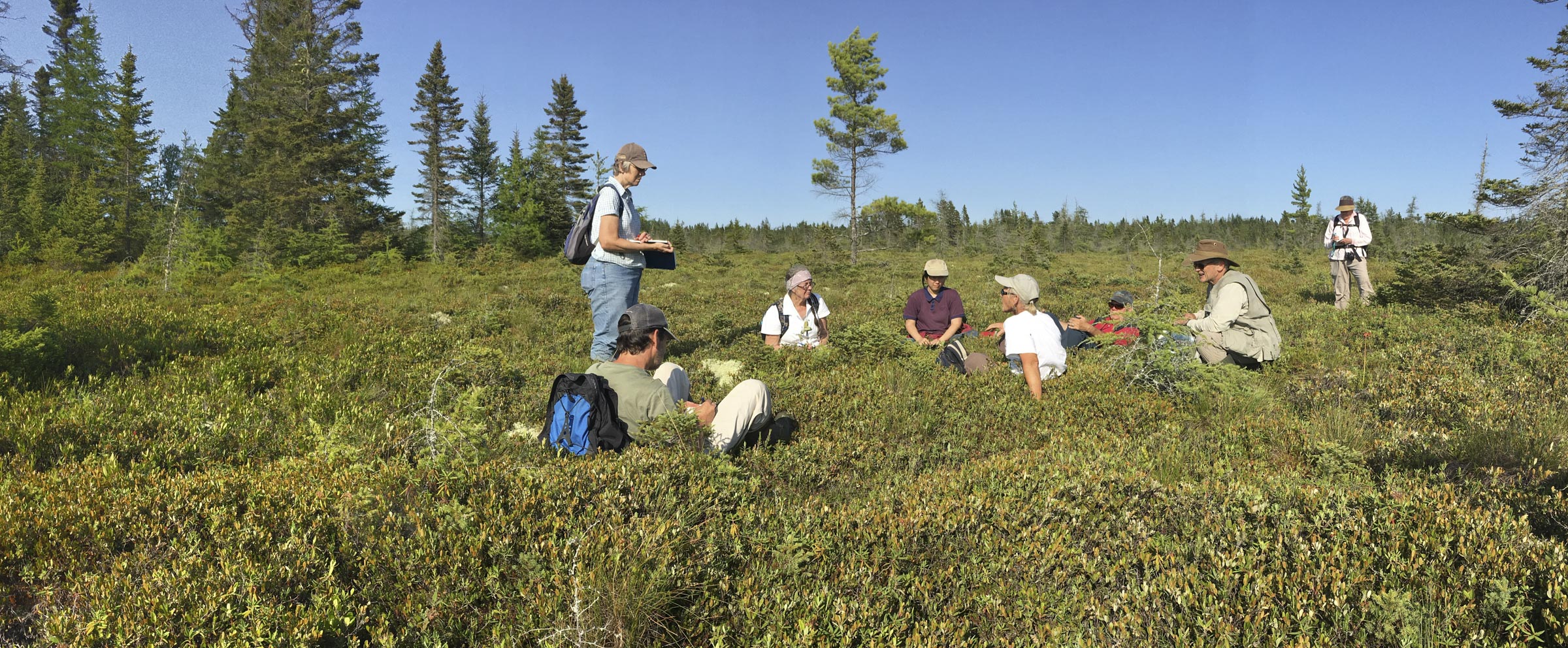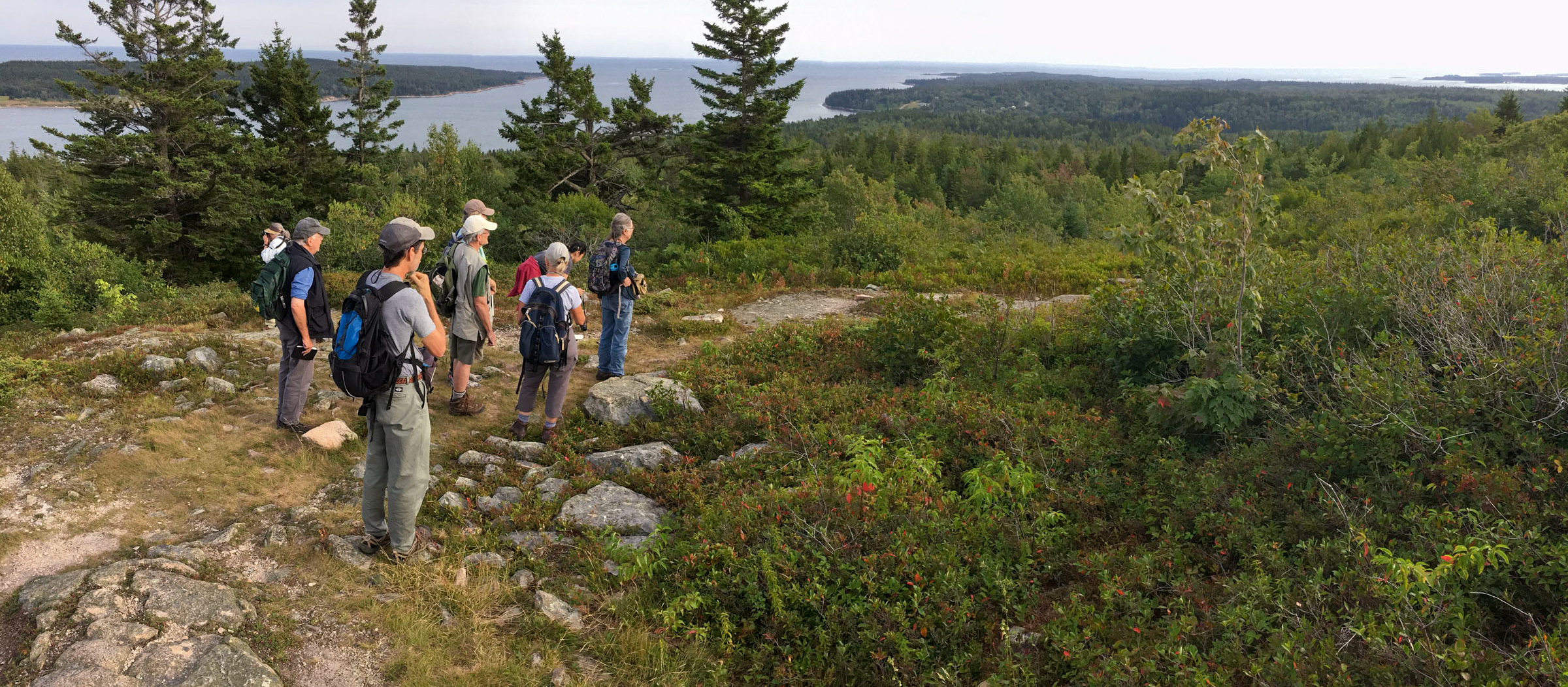Theme: Disturbance & Renewal
Memorial Day Weekend | May 28th – 30th
Eagle Hill Institute | Steuben, Maine
PRESENTATION RECORDINGS NOW AVAILABLE. Please see links in abstracts below.
Disturbance is around us and in us. It is an inevitable process in natural systems. It can uproot our personal and professional lives. It can trigger radical or imperceptible changes. It can be met with resilience, resistance, or redirection. Renewal, in some form, follows disturbance. This year, we’ll apply our FNEP minds to the flux of nature and our lived experiences.
Keynote Program | Tom Wessels
Coevolution: A Model for Sustainability
Watch Part 1 | Watch Part 2
This program will delve into the scientific principles of self-organization and coevolution. Self-organization works to create systems that are energy efficient, stable and resilient. We will then examine how this process happens in ecosystems through evolutionary time via coevolution creating biologically diverse ecosystems with robust networks of mutually beneficial relationships.
After gaining a theoretical foundation we will then discuss human systems from the perspective of coevolution to see ways we can create a far more sustainable future. We’ll then head into the field to find examples of coevolved, mutually beneficial interrelationships.

Presentation Abstracts
Evolution or Extinction — Nature Centers in the 2020s
Sean Beckett, Cohort AG | Watch the Recording
Director of Natural History Programs, North Branch Nature Center
Should we even bother with “environmental education” anymore? Is there a place for nature connection in a pandemic, a social justice reckoning, or a war? Does the “choir” really need more preaching? The last two years of the Anthropocene revealed much about our relationship with the environment (or lack thereof), and redefined the role of naturalists and nature centers in our society. From technology to stewardship to equity to design, Sean will share some of the successes and struggles at North Branch Nature Center as the organization adapted towards a messier and more meaningful role in the Central Vermont community. And we’ll hopefully deploy the FNEP hivemind on some of the thorny and existential questions that confront the field.
Downeast Maine 101
Tate Bushell, Cohort AA
Natural Lands Director, Land & Garden Preserve
What’s with all this moss? Where are the sugar maples? Why are these trees so short!? Great questions! Downeast Maine is a gem, but its biological richness is subtle. This talk is designed to orient you to Downeast Maine and provide some context to the symposium’s landscape. We will look at the ecosystem’s primary driver’s and discuss how they shape life on the coast for its human and non-human inhabitants.
What is “Urban” in Vermont?
Joanne Garton, Cohort AE | Watch the Recording
Urban Forester & Technical Assistance Coordinator, Urban & Community Forestry Program, Vermont Department of Forests, Parks and Recreation
May 16, 2018. “Today, 55% of the world’s population lives in urban areas, a proportion that is expected to increase to 68% by 2050. Projections show that urbanization, the gradual shift in residence of the human population from rural to urban areas, combined with the overall growth of the world’s population could add another 2.5 billion people to urban areas by 2050, with close to 90% of this increase taking place in Asia and Africa, according to a new United Nations data set launched today.” –News, United Nations, Department of Economic and Social Affairs
A postcard from Vermont, seen today at Morse Farm (a popular sugar shack in East Montpelier) captures the following: a covered bridge perched above a gushing brook, a mature sugar maple convening a small gathering of vibrant and leafy trees, a dusty road squirreling into the distance, and a barn leaning heavily into its granite foundation. There is not a soul in sight. If urbanity is in Vermont, how will it affect our brand? (Spoiler: It’s already here.)
Wildlife Tracking Science
Sophie Mazowita, Cohort AC | Watch the Recording
Conservation Science Coordinator, Cold Hollow to Canada
Operations Manager, Tracker Certification North America
Trained wildlife trackers can offer awareness of subtle wildlife sign and increase detection of otherwise elusive mammals, and there’s now a system in place to evaluate and certify trackers in these skills. I’ll offer examples of what can be documented with confidence through tracks and sign, then share case studies of three community science wildlife tracking projects that I’ve managed: the Burlington VT Mammal Tracking Project, the Community Wildlife Monitoring Project (Central Cascades, WA), and Cold Hollow to Canada’s (CHC) Keeping Track Monitoring Program. We’ll discuss the goals, hurdles and successes of these programs, then consider the current overhaul of the CHC program and the ‘disturbance and renewal’ that comes from a shift in project leadership. This 10-year-old monitoring program started with a research method rather than a question or a problem that needed solving, so we’ll examine the consequences of that design and the opportunity to re-engage wildlife trackers in meaningful field data collection.
Wildlife & Trail Recreation
Meredith Naughton, Cohort AJ | Watch the Recording
Conservation Program Manager, Stowe Land Trust
Trail recreation is growing in popularity as our society looks to the outdoors for wellness, camaraderie, and connection to the natural world. Vermont has seen this as particularly true because of the Covid-19 pandemic, which led more long-time residents and recent migrants to seek the enjoyment of our lands. However, trail recreation is not ecologically neutral and leads to disturbance of forests and wildlife. What do we know about the effects trail recreation has on wildlife and how do we manage trails to minimize their disturbance? This presentation describes the synthesis of scientific knowledge about the effect of trail recreation on wildlife in the northeast, and the patterns found across the literature. These patterns were used to inform management recommendations for balancing wildlife protection and recreation opportunities. Despite the many challenges of this topic affecting land managers across the region, there is scientifically informed work that can be done to promote an ecologically functional landscape.
All Hands on Deck — Watershed Planning in Vermont
Danielle Owczarski, Cohort AB | Watch the Recording
Watershed Planner, Vermont Department of Environmental Conservation
In 2016, the State of Vermont tasked itself with a big commitment to reduce phosphorus pollution to Lake Champlain by 34% over 20 years. Achieving pollution goals will ensure the lake is known for its clean water, not green water, keeping the lake in good shape for future generations of swimmers, anglers, birdwatchers, and boaters. A good chunk of the pollution reduction responsibility has been assigned to watershed-based Clean Water Service Providers and Basin Water Quality Councils, a collaborative of representatives from all walks of the water quality community. Join Vermont Watershed Planner, Danielle Owczarski, to learn about this one of a kind groundbreaking effort to build community-led regional pollution task forces in Vermont to save the waters of Lake Champlain.
Ecological Planning Laboratory
Walter Poleman, Cohort K | Watch the Recording
Director, Field Naturalist Program
This presentation will feature an idea for a new initiative based on a program innovation that Deane Wang and Jeffrey Hughes conceived of 20 years ago: Ecological Planning. Through a partnership with the Rubenstein School of Environment and Natural Resources, many graduate students joined the Field Naturalist family each year as Ecological Planners, a program model that flourished by focusing on the needs of local communities. Although UVM no longer offers a formal graduate track in ecological planning, we plan to build on its legacy by launching a new community outreach initiative known as the Ecological Planning Laboratory. Offered in collaboration with UVM Extension, the EPL would function as an “ecological extension service,” providing tangible opportunities for recent FN alumni to solve real-world conservation problems while helping to fulfill UVM’s land grant mission. We’re imagining that the EPL could be staffed in part by recent graduates of the program and provide ecological consulting services to range of organizations, municipalities, and agencies. While biodiversity conservation and ecosystem restoration would be central to the work of the EPL, a strong partnership with UVM Extension would provide a critical opportunity to work closely with communities seeking enhance their long-term resiliency in the face of climate change.
Field Walk Abstracts
Great Wass Island | Monday
Chris Schorn, Cohort AI
Senior Stewardship Manager, Midcoast Conservancy
See one of the gems of Downeast Maine! On this 5.5-mile hike, we’ll explore Great Wass Island, a 1,500 acre preserve owned by TNC. The first segment of the hike will go through a classic example of a Maritime Spruce-Fir Forest, the matrix community of much of the downeast coast. The trail will also pass through the largest contiguous jack pine (Pinus banksiana) woodland in Maine! After 1.5 miles, we’ll hit the rocky coast, and continue along the rocks (looking at tidepool critters as time allows!) to the southern end of the island before returning the way we came. If we are lucky, we’ll meet four amazing plants you won’t find almost anywhere else…come on the hike to learn more!
Note that this will be a long field day over sometimes-difficult rocky terrain, and is an hour further up the coast from Eagle Hill–but there’s simply no other place like it! We will likely need to carpool from a point TBD–if you are interested in coming and have room to spare in your car for others, let us know! We expect to return to the parking lot by 4pm. Contact Chris Schorn at caschorn@gmail.com or 202-841-9606 with questions.
Pinkham Bridge Saltmarsh | Monday
Jill Weber
Consulting Botanist, Bar Harbor
Join local botanist and sedge expert Jill Weber for an exploration of one of Maine’s tidal wetland communities: the Spartina Saltmarsh. This site is conveniently located just 7 minutes north of Eagle Hill, on the way to Rt. 1. This saltmarsh sits at the head of Pinkham Bay, between Dyer Neck and Petit Manan Point. The low marsh is dominated by Spartina patens with other typical saltmarsh species, including Triglochin maritima, Salicornia depressa, and Suaeda maritima. Moving toward the upland to the high marsh, the conditions become more brackish and Spartina alterniflora, Solidago sempervirens, Juncus gerardii, Carex paleacea are common. A stand of sweetgrass, Anthoxanthum nitens, is present.
Seaweeds of Maine | Sunday
Jordan Chalfant
Seaweed Naturalist
Early-risers on Sunday may enjoy a 1.5hr intertidal excursion exploring the diversity of seaweed species in this region. Over 300 species of macroalgae can be found on the coast of Maine. Participants will learn the names and identifying characters of common ones, and there will be a discussion of intertidal ecology: how these species interact and create a marine-version of our familiar plant communities.
Jordan Chalfant is a board member at Maine Natural History Observatory. She and MNHO director, Glen Mittelhauser, are working on a field guide to the seaweeds of Maine. Jordan’s day job is managing the Naturalist’s Notebook, a nature and science exploratorium and bookstore in Seal Harbor.


